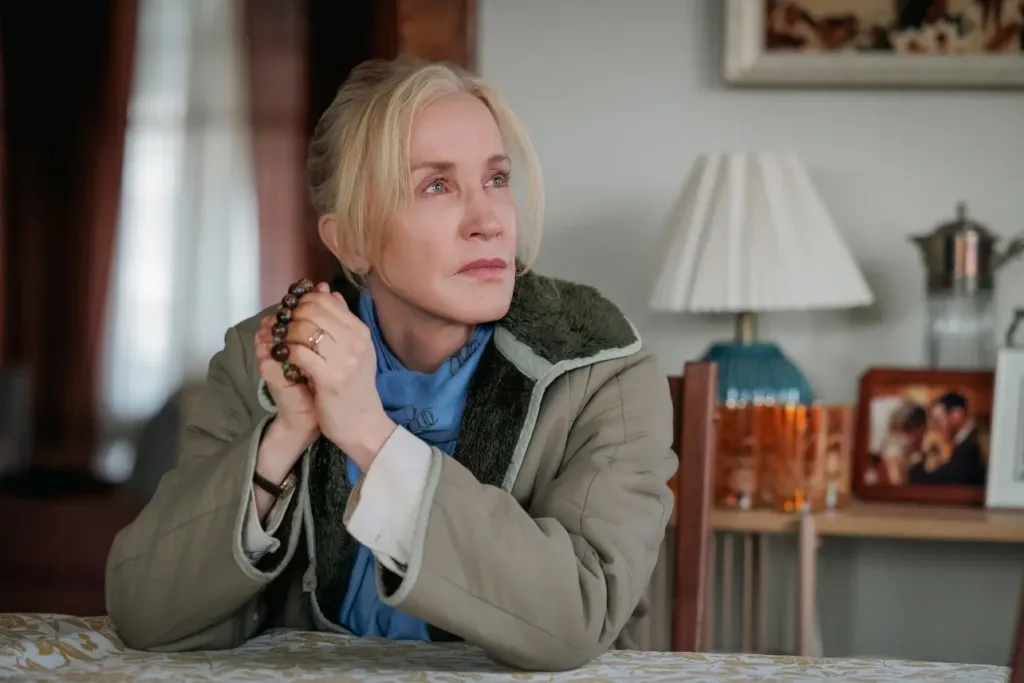Imagine a life rebuilt from ashes, quiet and orderly, only to have the specter of your past appear on your doorstep. This is where we meet Rena in The Thirteenth Wife: Escaping Polygamy. She tends to her garden, a picture of tranquil domesticity, before a news report about a violent shootout with a Mexican cult shatters her peace.
The real catalyst arrives in the form of Josie, a reporter who knows exactly who Rena used to be. This encounter forces Rena to unlock a lifetime of trauma and recount her story as the thirteenth wife of Ervil LeBaron, a charismatic and monstrous self-proclaimed prophet.
The film immediately positions itself as a harrowing biographical thriller, not just about escaping a physical place, but about the impossibility of escaping memory itself. It explores the deep scars of psychological captivity and the sheer will required to survive when your entire world was designed to control you.
A Fractured Timeline
The film’s primary storytelling device is the dual timeline, a narrative mechanic that can be incredibly effective when paced correctly. The entire story is framed through the present-day interview between an older, weathered Rena, played by Felicity Huffman, and the probing reporter.
This conversation serves as the gateway to the turbulent 1960s and 70s, where we witness the story’s true beginning. We see how missionaries Ervil and Joel LeBaron first approached Rena’s family, their words slowly poisoning the well of faith until the family relocates to a remote compound in Chihuahua, Mexico.
The film effectively shows Ervil’s method: a mix of personal charm and promises of a divine role that convinced followers to give him everything. The narrative gains a key point of tension when Ervil’s ambition leads to a schism with his brother, prompting him to form his own violent sect.
The constant shifting between the quiet reflection of the present and the visceral chaos of the past occasionally makes the pacing feel uneven. This disjointed structure, however, powerfully mirrors the fragmented nature of traumatic memory, making the viewer experience Rena’s fractured psychological state firsthand.
The Doctrine of Fear
At the heart of Ervil LeBaron’s control was his doctrine of “blood atonement,” a chilling belief that murdering his enemies was a holy act. This principle serves as the central rule in the dark world Rena inhabits. The film details the insidious grooming process, showing how Ervil manipulated the youth, taking Rena on “shopping” trips that were thinly veiled transactions for her loyalty.
Her personal struggle is amplified when a budding romance with a young man is abruptly severed by Ervil, who declares that God has chosen Rena to be his next wife. From there, she is pulled into the cult’s violent machinery, acting as a getaway driver and even being ordered to kill.
The film excels at building an atmosphere of intense paranoia, where the penalty for doubt or an attempt to flee was death, a reality underscored by the murder of Rena’s pregnant friend. What makes the story so gripping is its psychological honesty; Rena admits that despite the abuse, the cult was the only family and world she knew, making the choice to leave an almost impossible one.
The Human Element
A story this intense lives or dies by its performances, and The Thirteenth Wife is largely a success on this front. Olga Petsa, as the young Rena, is the film’s emotional core. She delivers a haunting performance, capturing the terror, conflict, and eventual spark of resilience of a girl whose youth was stolen.
As the villainous Ervil LeBaron, Eric Johnson channels a compelling brand of charismatic evil, though some of his bigger emotional outbursts border on caricature, slightly diminishing his menace. Felicity Huffman portrays the older Rena with a quiet, wounded dignity, but her role functions more as a narrative guide than a fully active character.
Director Michael Nankin handles the material with a steady hand, particularly in the violent scenes, where handheld camerawork creates a raw, unsettling intimacy. The film’s visual palette feels authentic, avoiding the overly polished look of many TV movies. One small misstep is the recurring visual of a paper calendar to signify the year, a clumsy choice that momentarily pulls you out of the otherwise immersive experience.
The Thirteenth Wife: Escaping Polygamy is a two-part Lifetime miniseries that premiered on May 31 and June 1, 2025. The film dramatizes the harrowing true story of Rena Chynoweth, who, at the age of 16, was coerced into marrying Ervil LeBaron, the leader of a violent polygamist cult. Filmed in British Columbia, Canada, the miniseries is available for streaming on Lifetime’s official platforms and select services like Sling TV, FuboTV, and DIRECTV.
Full Credits
Director: Michael Nankin
Writer: Stephen Tolkin
Producers: Susanne Belzberg, Doran Chandler, Amy Hartwick
Executive Producers: Brad Krevoy, Amy Hartwick
Cast: Felicity Huffman, Olga Petsa, Eric Johnson, Michelle Harrison, Adrian Petriw, Jonathan Whitesell, Jessie Fraser, Matthew Nelson-Mahood, Barry W. Levy, Rubi Tupper, Arlina Rodriguez, Roman Kinsella, Haven Gin, Kellen Bruce, Anthony Bolognese, Shyinne Anastacio, Andres Collantes, Erik Kavanagh, Manny Hernandez
Filming Locations: Kelowna and Thompson-Nicola Regional District, British Columbia, Canada
The Review
The Thirteenth Wife: Escaping Polygamy
The Thirteenth Wife: Escaping Polygamy is a powerful and unsettling depiction of psychological abuse, anchored by a haunting lead performance. While its narrative structure can feel disjointed and its villain occasionally veers into caricature, the film's raw execution and unflinching look at the complexities of trauma make it a compelling and important watch. It successfully translates a horrific true story into a gripping tale of survival that lingers long after the credits roll.
PROS
- A chilling and unforgettable true story.
- Effective portrayal of psychological manipulation and control.
- Olga Petsa's powerful performance as young Rena.
- Raw, intense direction that enhances the story's horror.
CONS
- The villain's performance can feel exaggerated at times.
- Uneven pacing due to the dual-timeline structure.
- Felicity Huffman is underutilized in a narrator-like role.
















































